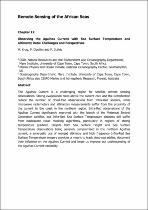 ResearchSpace
ResearchSpace
Observing the Agulhas Current with sea surface temperature and altimetry data: challenges and perspectives
JavaScript is disabled for your browser. Some features of this site may not work without it.
- ResearchSpace
- →
- Research Publications/Outputs
- →
- Book Chapters
- →
- View Item
| dc.contributor.author |
Krug, Marjolaine J

|
|
| dc.contributor.author |
Cipollini, P

|
|
| dc.contributor.author |
Dufois, F

|
|
| dc.date.accessioned | 2015-10-07T06:17:48Z | |
| dc.date.available | 2015-10-07T06:17:48Z | |
| dc.date.issued | 2014-06 | |
| dc.identifier.citation | Krug, M.J., Cipollini, P. and Dufois, F. 2014. Observing the Agulhas Current with Sea Surface Temperature and Altimetry Data: Challenges and Perspectives. In: Remote sensing of the African Seas. Springer, Netherlands | en_US |
| dc.identifier.isbn | 978-94-017-8007-0 | |
| dc.identifier.uri | http://link.springer.com/chapter/10.1007%2F978-94-017-8008-7_12 | |
| dc.identifier.uri | http://hdl.handle.net/10204/8159 | |
| dc.description | Copyright: Springer Netherlands. Due to copyright restrictions, the attached PDF file contains the abstract of the full text item. For access to the full text item, please consult the publisher's website. | en_US |
| dc.description.abstract | The Agulhas Current is a challenging region for satellite remote sensing observations. Strong evaporation rates above the current core and the Retroflection reduce the number of cloud-free observations from Infra-Red sensors, while microwave radiometers and altimeters measurements suffer from the proximity of the current to the coast in the northern region. Infra-Red observations of the Agulhas Current significantly improved with the launch of the Meteosat Second Generation satellite, but Infra-Red Sea Surface Temperature datasets still suffer from inadequate cloud masking algorithms, particularly in regions of strong temperature gradient. Despite both Sea Surface Height and Sea Surface Temperature observations being severely compromised in the northern Agulhas current, a synergetic use of merged altimetry and high frequency Infra-Red Sea Surface Temperature imagery provides a means to track deep-sea eddies, document their influence on the Agulhas Current and helps us improve our understanding of the Agulhas Current variability. | en_US |
| dc.language.iso | en | en_US |
| dc.publisher | Springer Netherlands | en_US |
| dc.relation.ispartofseries | Workflow;14871 | |
| dc.subject | Agulhas current | en_US |
| dc.subject | Altimetry data | en_US |
| dc.subject | Oceanology | en_US |
| dc.title | Observing the Agulhas Current with sea surface temperature and altimetry data: challenges and perspectives | en_US |
| dc.type | Book Chapter | en_US |
| dc.identifier.apacitation | Krug, M. J., Cipollini, P., & Dufois, F. (2014). Observing the Agulhas Current with sea surface temperature and altimetry data: Challenges and perspectives., <i>Workflow;14871</i> Springer Netherlands. http://hdl.handle.net/10204/8159 | en_ZA |
| dc.identifier.chicagocitation | Krug, Marjolaine J, P Cipollini, and F Dufois. "Observing the Agulhas Current with sea surface temperature and altimetry data: challenges and perspectives" In <i>WORKFLOW;14871</i>, n.p.: Springer Netherlands. 2014. http://hdl.handle.net/10204/8159. | en_ZA |
| dc.identifier.vancouvercitation | Krug MJ, Cipollini P, Dufois F. Observing the Agulhas Current with sea surface temperature and altimetry data: challenges and perspectives.. Workflow;14871. [place unknown]: Springer Netherlands; 2014. [cited yyyy month dd]. http://hdl.handle.net/10204/8159. | en_ZA |
| dc.identifier.ris | TY - Book Chapter AU - Krug, Marjolaine J AU - Cipollini, P AU - Dufois, F AB - The Agulhas Current is a challenging region for satellite remote sensing observations. Strong evaporation rates above the current core and the Retroflection reduce the number of cloud-free observations from Infra-Red sensors, while microwave radiometers and altimeters measurements suffer from the proximity of the current to the coast in the northern region. Infra-Red observations of the Agulhas Current significantly improved with the launch of the Meteosat Second Generation satellite, but Infra-Red Sea Surface Temperature datasets still suffer from inadequate cloud masking algorithms, particularly in regions of strong temperature gradient. Despite both Sea Surface Height and Sea Surface Temperature observations being severely compromised in the northern Agulhas current, a synergetic use of merged altimetry and high frequency Infra-Red Sea Surface Temperature imagery provides a means to track deep-sea eddies, document their influence on the Agulhas Current and helps us improve our understanding of the Agulhas Current variability. DA - 2014-06 DB - ResearchSpace DP - CSIR KW - Agulhas current KW - Altimetry data KW - Oceanology LK - https://researchspace.csir.co.za PY - 2014 SM - 978-94-017-8007-0 T1 - Observing the Agulhas Current with sea surface temperature and altimetry data: challenges and perspectives TI - Observing the Agulhas Current with sea surface temperature and altimetry data: challenges and perspectives UR - http://hdl.handle.net/10204/8159 ER - | en_ZA |





